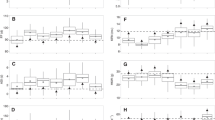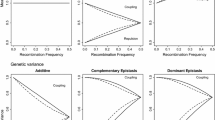Abstract
Through the concerted use of doubled haploidy (DH), molecular markers and off-season nurseries, maize (Zea mays L.) breeders have unprecedented capabilities to quickly and precisely create progeny with desired levels of similarity to either parents of a commercial hybrid. Genotypic data from both simulated and from actual populations created either by single seed descent or through doubled haploidy were examined for the initial and subsequent generations. Simulation data showed that DH progeny inherited larger blocks of parental chromosomes; approximately seven out of 10 chromosomes had intact segments of 50% or greater. By the third DH generation progeny can be selected that are more than 90% similar to either parent of the initial commercial hybrid. Actual marker data from the initial DH generation showed a maximum parental contribution of 88.4% compared to 78.7% for progeny developed by single seed descent (SSD). The number of intact chromosomes was higher among DH progeny than among progeny bred by SSD. Use of DH facilitates access to germplasm that is already present in commercial maize hybrids. Available technologies coupled with the intellectual property protection regime will influence decisions made by plant breeders in the balance of exotic compared to well-adapted germplasm they choose to access for further cycles.







Similar content being viewed by others
References
Baenziger PS (1996) Reflections on doubled haploids in plant breeding. pp35–48 In: Jain SM, Sopory SK, Veilleux RE (eds) In vitro haploid production in higher plants. Kluwer Academic, Dordrecht, Netherlands, p 356
Baenziger PS, Kudirka DT, Schaeffer GW, Lazar MD (1984) The significance of doubled haploid variation. In: Gustafson JP (ed) Gene manipulation in plant improvement. Plenum Press, New York, pp 385–414
Bernardo R (2003) Parental selection, number of breeding populations, and size of each population in inbred development. Theor Appl Genet 107:1252–1256
Berry DA, Seltzer JD, Xie C, Wright DL, Smith JSC (2002) Assessing probability of ancestry using simple sequence repeat profiles: applications to maize hybrids and inbreds. Genetics 161:813–824
Bonnet DG, Rebetzke GJ, Spielmeyer W (2005) Strategies for efficient implementation of molecular markers in wheat breeding. Mol Breeding 15:75–85
Brummer EC (2004) Applying genomics to alfalfa breeding programs. Crop Sci 44:1904–1907
Choo TM, Reinbergs E, Kasha KJ (1985) Use of haploids in breeding barley. Plant Breed Rev 3:219–252
Dirks RHG, van Dun CMP, Reinink K (2003) Reverse Breeding. Intl. Publ. No. WO 03/017753 A2. World Intellectual Property Organisation. Geneva, Switzerland, p 83
Dubcovsky J (2004) Marker-assisted selection in public breeding programs: the wheat experience. Crop Sci 44:1895–1898
Frisch M, Melchinger AE (2006) Marker-based prediciton of the parental genome contribution to inbred lines derived from biparental crosses. Genetics 174:795–803
Frisch M, Melchinger AE (2007) Variance of the parental genome contribution to inbred lines from biparental crosses. Genetics e publication. doi:10.1534/genetics.106.065433
Goodman MM (2005) Broadening the U.S. maize germplasm base. Maydica 50:203–214
Heckenberger M, Bohn M, Melchinger AE (2005) Identification of essentially derived varieties obtained from biparental crosses of homozygous lines: i. simple sequence repeat data from maize inbreds. Crop Sci 45:1120–1131
Koornneef M, Stam P (2001) Changing paradigm in plant breeding. Plant Physiol 125:156–159
Kuchel H, Ye G, Fox R, Jefferies S (2005) Genetic and economic analysis of a targeted marker-assisted wheat breeding strategy. Mol Breeding 16:67–78
Lu H, Bernardo R (2001) molecular marker diversity among current and historical maize inbreds. Theor Appl Genet 103:613–617
Mohan M, Nair S, Bhagwat A, Krishna TG, Yano M, Bhatia CR, Sasaki T (1997) Genome mapping, molecular markers and marker-assisted selection in crop plants. Mol Breeding 3:87–103
Murigneux A, Barloy D, Leroy P, Beckert M (1993) Molecular and morphological evaluation of doubled haploid lines in maize. I. homogeneity within DH lines. Theor Appl Genet 86:837–842
Peleman JD, van der Voort JR (2003) Breeding by design. Trends Plant Sci 8:330–334
Podlich DW, Cooper M (1998) QU-GENE: a simulation platform for quantitative analysis of genetic models. Bioinformatics 14:632–653
Rober FK, Gordillo GA, Geiger HH (2005) In Vivo haploid induction in maize—Performance of new inducers and significance of doubled haploid lines in hybrid breeding. Maydica 50:275–283
Schmierer DA, Kandemir N, Kudrna DA, Jones BL, Ullrich SL, Kleinhofs A (2004) Molecular marker-assisted selection for enhanced yield in malting barley. Mol Breeding 14:463–473
Schon CC, Utz HF, Groh S, Truberg B, Openshaw S, Melchinger AE (2004) Quantitative Trait locus mapping based on resampling in a vast maize testcross experiment and its relevance to quantitative genetics for complex traits. Genetics 167:485–498
Tanksley SD, McCouch SR (1997) Unlocking genetic potential from the wild. Sci 277:1063–1066
Tartar JA, Goodman MM, Holland JB (2004) Recovery of exotic alleles in semiexotic maize inbreds derived from crosses between latin american accessions and a temperate line. Theor Appl Genet 109:609–617
UPOV (1978) International Convention for the Protection of New Varieties of Plants. http://www.upov.int/en/publications/conventions/1978/content.htm
UPOV (1991) International Convention for the Protection of New Varieties of Plants. http://www.upov.int/en/publications/conventions/1991/content.htm
Wang J, Bernardo R (2000). Variance of marker estimates of parental contribution to F2 and BC1-Derived Inbreds. Crop Sci 40:659–665
Yau Y-Y, Santos K, Simon P (2005) Molecular tagging and selection for sugar type in carrot roots using co-dominant, PCR-based markers. Molec Breeding 16:1–1
Author information
Authors and Affiliations
Corresponding author
Rights and permissions
About this article
Cite this article
Smith, J.S.C., Hussain, T., Jones, E.S. et al. Use of doubled haploids in maize breeding: implications for intellectual property protection and genetic diversity in hybrid crops. Mol Breeding 22, 51–59 (2008). https://doi.org/10.1007/s11032-007-9155-1
Received:
Accepted:
Published:
Issue Date:
DOI: https://doi.org/10.1007/s11032-007-9155-1




